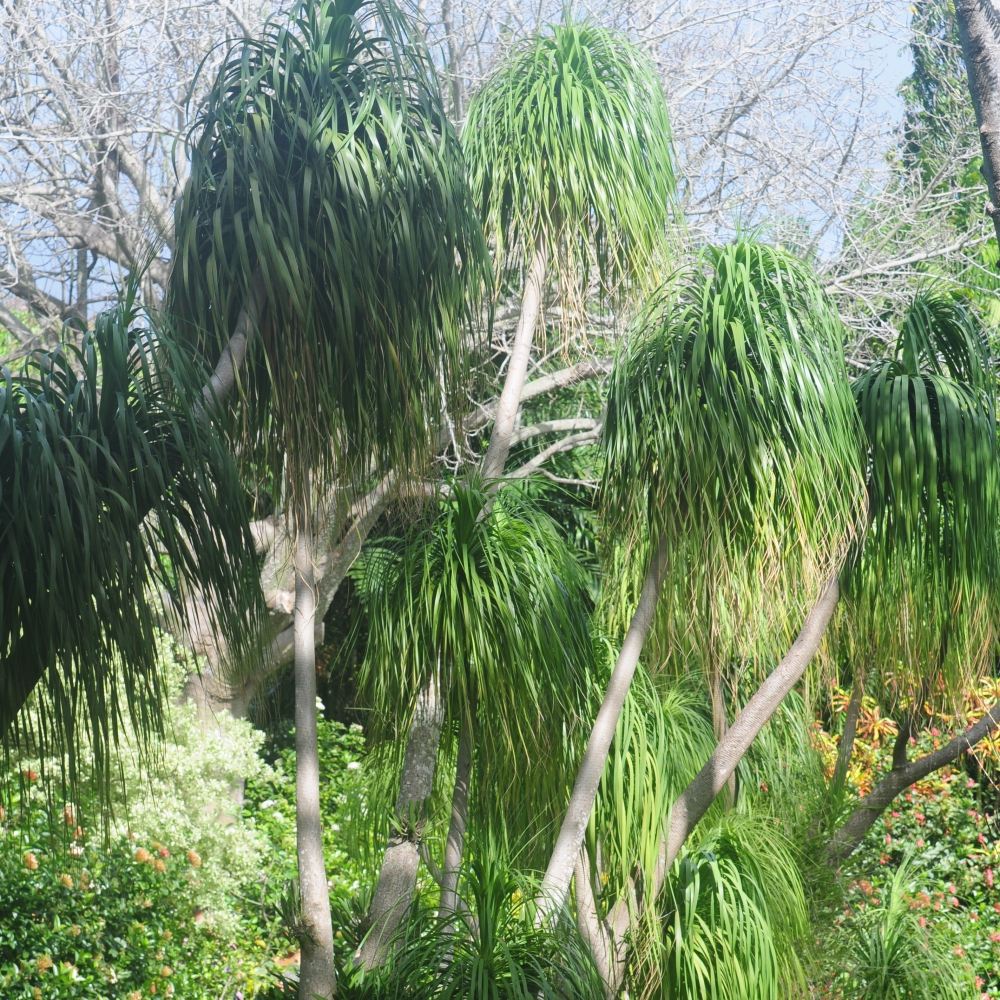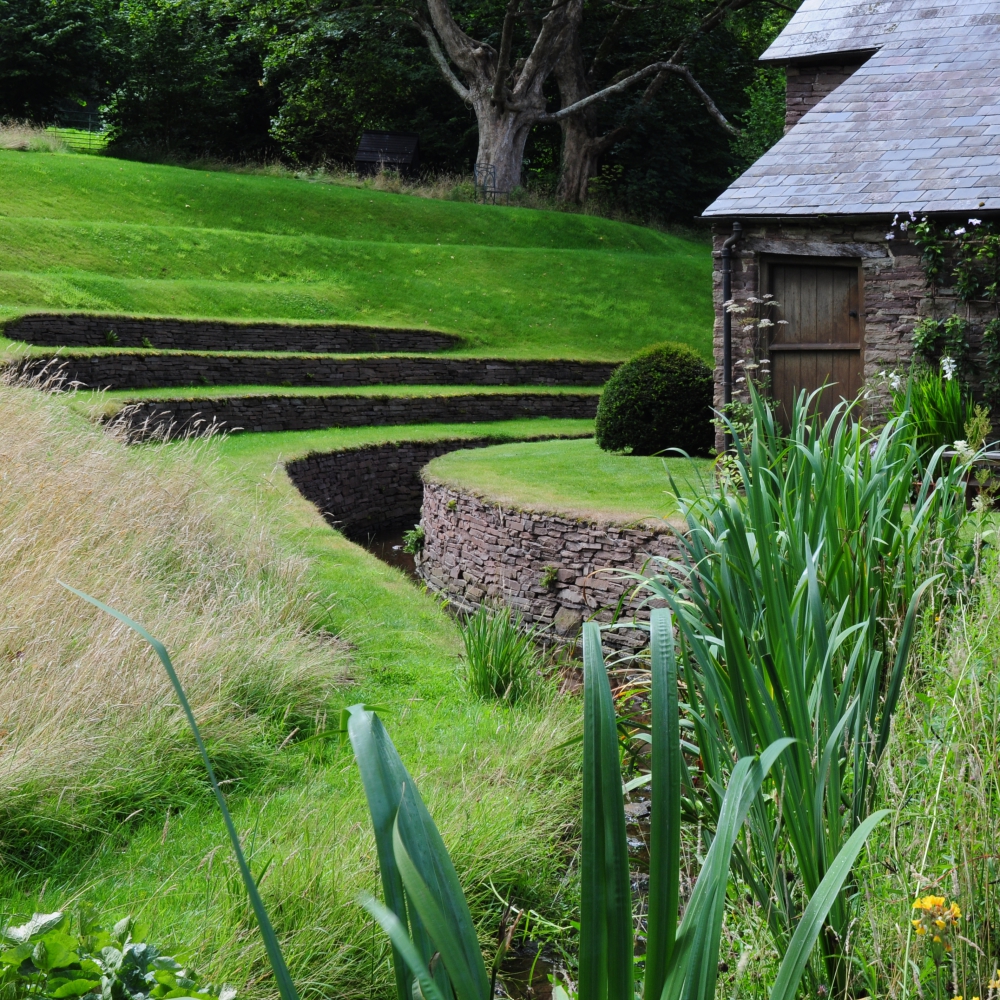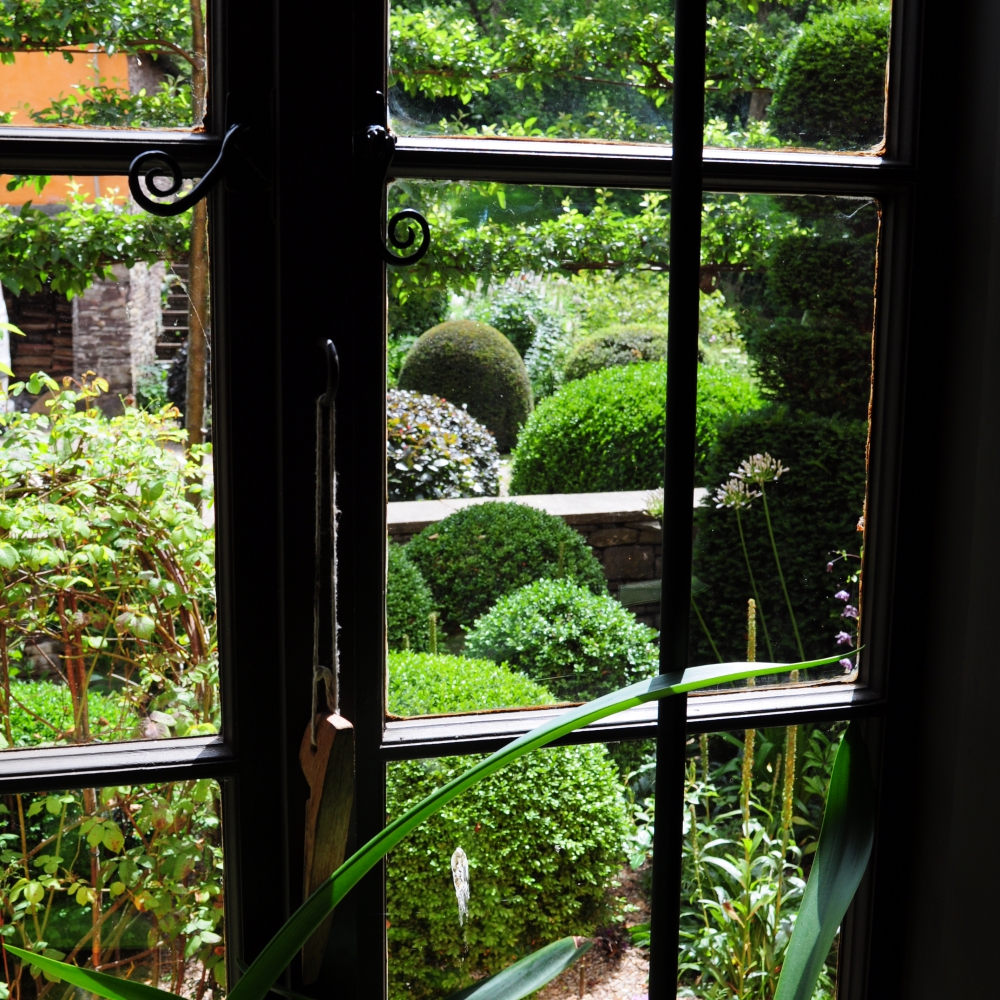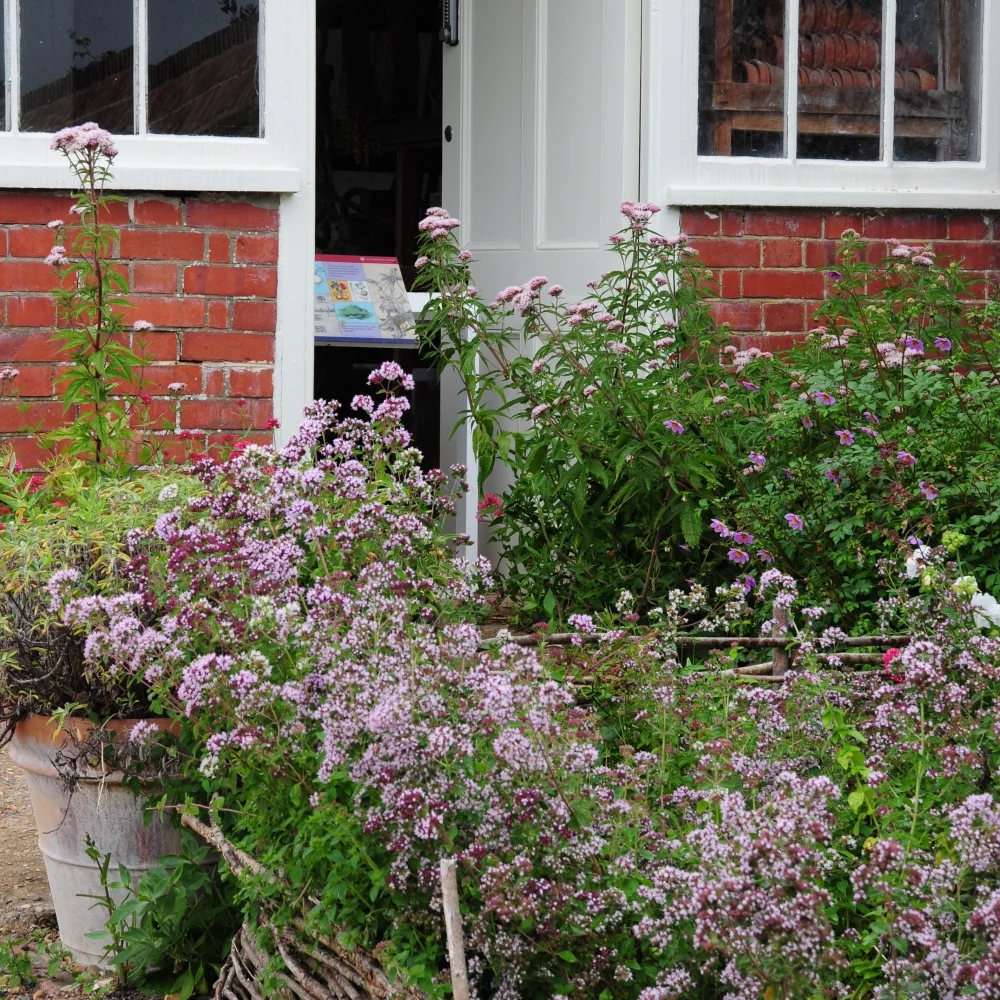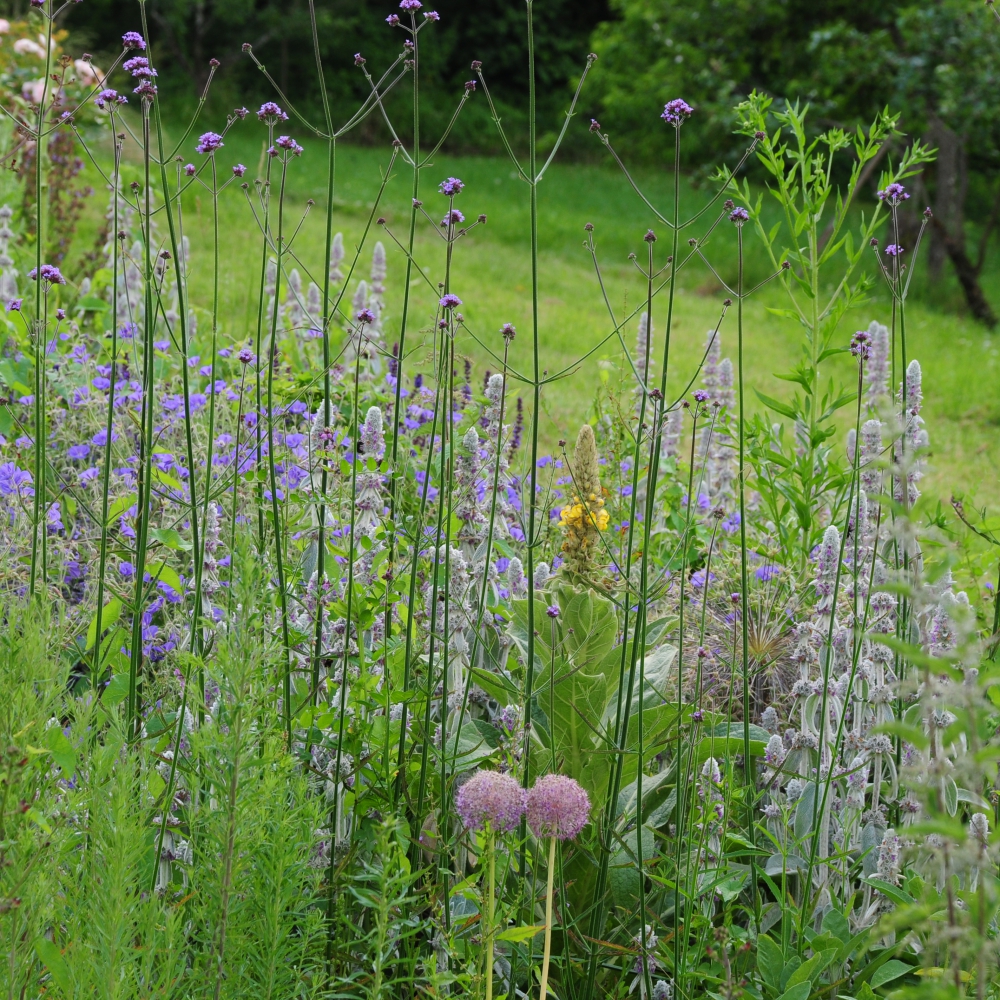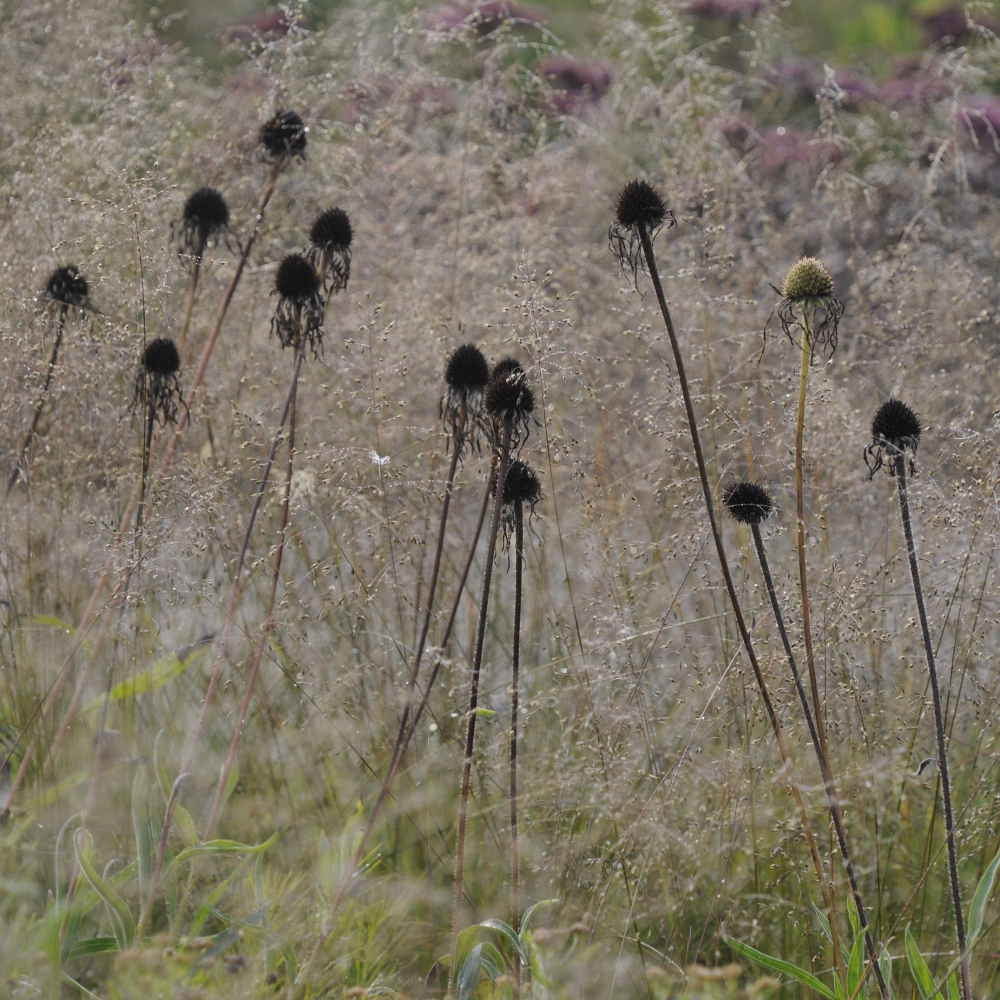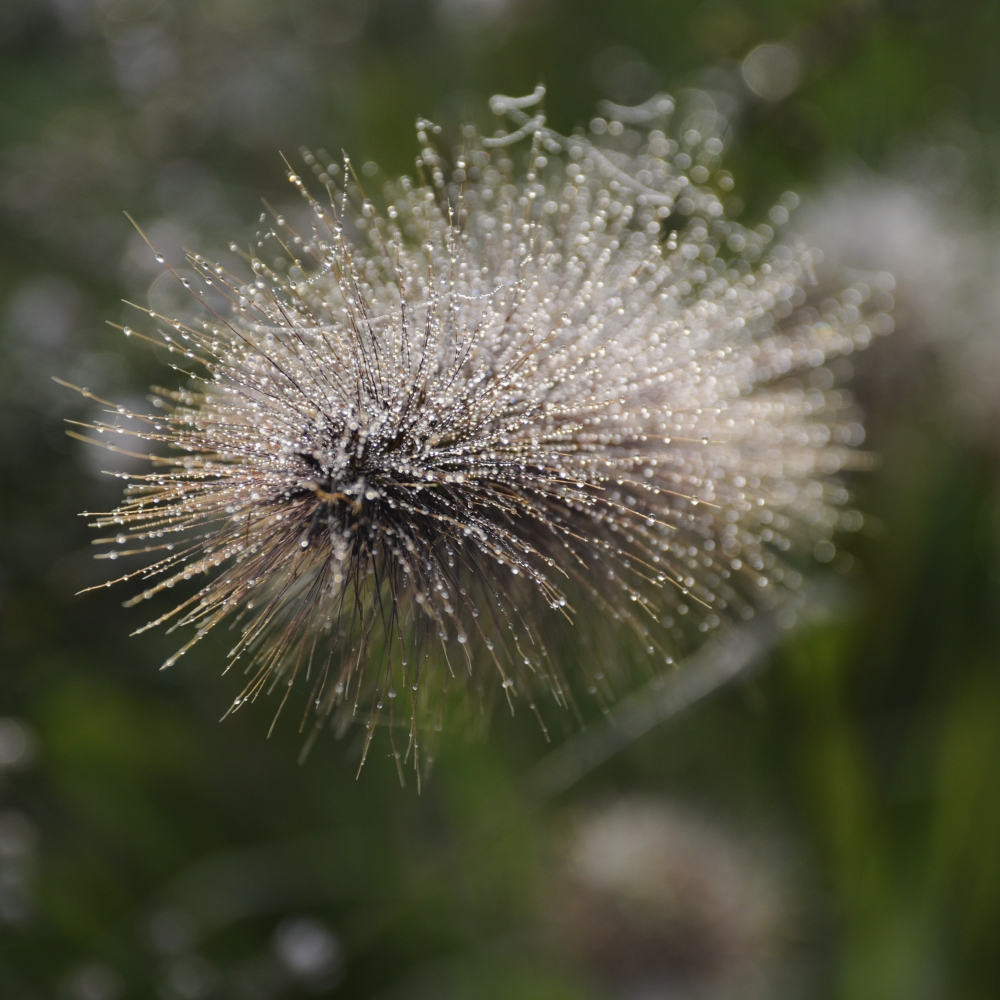Ole Dam Mikkelsen's garden
Ole Dam Mikkelsen has made this magnificent garden in Barbados from an abandoned sugar cane field in just 33 years. It is full of huge trees, orchids, cacti and palms - only in the tropics can trees this size reach maturity in such a short time.
The tree on the left I was told is a coolie nut tree from Brazil. I've tried to look it up without success.
I hope you will bear with me in my ignorance of most of the plants in this garden. It is extraordinarily difficult to find the names of plants just by googling "tropical plant with stripey leaves" for example, or "tree with spikey bark from Barbados". The flower above is called Cat's whiskers but I've no idea what the Latin name is.
This one, Hura crepitans, is known locally as the sandbox tree, monkey no climb and also the dynamite tree (the sound the fruit makes when it splits). The sap has been used to poison fish and the unripe seeds were sawn in half to make sandboxes for pens.
One of the main features of this garden was the variety of trees. This one, I have found, is the Silk Tassle Tree.
This tree featured on a Gardener's World programme recently but I can't find the episode to get the name.
However, even I could identify tiny mangoes.
And breadfruit, although I've still never eaten one. Breadfruit trees (Artocarpus altilis) were brought to the Caribbean by Captain Bligh from the South Pacific for the express purpose of feeding slaves. It is one of the highest yielding fruit trees, producing up to 150 fruits a year, each weighing up to 6kg. Nutritionally it is still an important food, high in vitamins C and B3, potassium and omegas 3 and 6.
What on earth is this? There was a row of them, each about 10m tall.
And these are the roots of a large fig tree, looking like a box of snakes.
The foliage, mostly evergreen, is pretty spectacular as well.
Not always very friendly, unusual for Barbados.
The flowers are vivid in colour and dramatic in form. This is Adenium obesum, known as the desert rose in Barbados, although it is thought to have come from East Africa originally. It flowers in the dry season (winter in Barbados) when most of the leaves drop off, leaving just these flourescent flowers on display.
Here are the stripey leaves. I doubt I would plant this in a garden in the UK but here it looks fab.
This is some sort of semperviven, or maybe an aloe..
Now, where's that rum punch?
Chateau Villandry
My first vist to Chateau Villandry was pretty inauspicious. On a cycling tour of the Loire with friend Helen, I was pretty chateau'd out by the time we got to Villandry. Helen was still game for yet another chateau tour but I opted to sit outside and read a book. A couple of decades later (maybe more), on another cycling holiday, I found out what I'd missed.
There's been a building on this site since 1189 but the Chateau as it stands to date was built around 1536. It was the last of the great renaissance chateaux to be built along the Loire. By the 19th century the chateau had an English style park around it but in 1906 it was bought by a Spaniard, Joachim Carvallo, who was determined to reinstate the original renaissance gardens.
The gardens are extremely formal, symmetrical, loaded with symbolism and mostly set out in the form of parterres. This means they are best viewed from above, historically from inside the chateau, but also from various vantage points around the garden. The scale of the gardens, and the intensity with which they are gardened, is quite astonishing.
The Ornamental Garden contains several parterres symbolising different forms of love - "tender love", "flighty love" etc, etc. Another parterre contains a Maltese Cross, a Languedoc cross, a Basque cross and stylised representations of fleurs de lys.
At the top of the garden is a huge ornamental lake set out in the shape of a Louis XV mirror. At first I thought this quite a boring part of the garden, there is little planting here, just a few pieces of topiary and some fountains set below a cloister-like walk under lime trees. However, it is the least busy part of the gardens (in terms of pattern and planting) and feels quite restful.
The Sun Garden is the most recent addition to the gardens at Villandry, designed in 2008 to make the centenary of Carvallo's restoration. It consists of childrens' room (a must these days I suppose), a sun room of oranges and yellows (my favourite)
and a cloud room of blues and whites.
One part of the garden, which doesn't seem to have a name, combined the formality of a box parterre with the informaility of planting in the Sun Room.
The blue flowers are mostly Perovskia and Salvia uglinosa and the pink are Gaura Rosyjane.
The largest part of the garden is the vegetable garden. Although the production of fruit and vegetables seems to be important the emphasis is on combining colour schemes with botanic science. The garden is planted twice a year and is now organic. Everything is still planted in box-lined symmetrical beds of course.
Companion planting is used to protects crops from pests and diseases.
One of the best things about gardens like this is finding corners that you're not sure you're supposed to be in, like this glasshouse. More art nouveau than renaissance, but still fab.
As usual there wasn't time, and less inclination, to go inside the Chateau. There was a tearoom but it was outside and it was raining and I didn't think the tea would be up to much. And there was the thought of dinner here - http://www.letapegourmande.com/ to keep me going. It was worth it (as was the long walk uphill to get there).
Thanks to Rachel and Chris for a fab holiday.
Chateau Villandry - http://www.chateauvillandry.fr/en/ By the way - ten full-time gardeners work here...
For more information about the bike ride - https://inspiringbikerides.co.uk/bike-ride/france-the-loire/
Allt-y-bela
Allt-y-bela is designer Arne Maynard's garden in Monmouthshire. Initially, it was Arne's intention to make a simple garden using his favourite components - roses, topiary and wildflower meadows. There was no garden here when Arne bought the restored medieval farmhouse five years ago, just a few outbuildings set across an ancient drover's road.
The topiary, mostly set around the house, is huge and dramatic, and seemingly randomly placed. His gardener, Steve, said it was not unusual for Arne to receive deliveries of large pieces without much forethought as to where they would be placed.
None of the pieces are alike and there is no attempt at placing them in a formal pattern. The larger pieces are a mixture of yew, hornbeam, purple beech and box. Low hawthorn hedges have just been planted to create rustic edges for the few formal borders.
There is a pleasing lack of formality to the garden as it is the designer's intention to blue the boundaries between the garden and the wider landscape. Beyond the immediate vicinity of the house the garden is surrounded by wildflower meadows. At the end of summer the flowers have all faded but in spring thousands of bulbs are in flower, designed to make the meadows look as though they've been there for hundreds of years.
In keeping with the house's agricultural history there is a productive and beautiful Kitchen Garden.
By the way, the house was white when Arne bought it. I don't know how he came to choose orange as the right colour to paint it but it makes a stunning backdrop to the garden, mainly because green really stands out against it. And when you've got an orange house you need a few orange flowers.
Next to the Kitchen Garden is the Cottage Garden, full of flowers to be cut for the house. The paths are made from stone found around the house and are angled to provide interesting glimpses of other parts of the house. These foxgloves are Digitalis ferruginea gigantea.
Despite his best intentions Arne has been unable to resist the urge to go beyong his original brief. The stream behind the old granary has been canalised with local stone and divides the stage from the terraces that form the Garden Theatre.
The gardens immediately outside the house are more complex, though still informal.
The Courtyard Garden at the front is enclosed with a pleached hedge and filled with smaller pieces of topiary and cottage-style planting, making for an interesting view from the kitchen.
One of my favourite spots in the garden is at the back of the house. Box hedging reaches out towards the meadow.
It is here the roses are most in evidence. Although by late summer they are mostly past their best they must look and smell amazing in June.
Back towards the front of house, next to the granary, is Arne's latest project, the Lattice Garden. Low hedges of hawthorn frame herbaceous planting and topiary.
espite being a two-time gold medal winner at Chelsea, there's still room a little whimsy in the garden (or was it there already when he bought the property?).
Little of this garden would be possible without full-time gardener Steve Lannin. Although the topiary is only trimmed once a year apparently it can take weeks to get all the way round the garden. Steve was a warm and knowledgeable host on our visit and really brough Arne's design ideas to life.
t is difficult to explain how much I enjoyed this garden; it's quite different to any other garden I have seen. There really is a blurring between the garden and the wider landscape and the huge topiary adds unexpected scale and drama. I didn't feel as though I were in a garden in the normal sense - there were no boundaries - just endless possibilities of walking round the garden with different views at each turn. Quite an achievement.
The garden at Allt-y-bela is not open to the public but group visits can be arranged. Alternatively, you can stay in the house as a B&B and have the garden all to yourself.
Allt-y-bela - http://arnemaynard.com/portfolio/gardens/my-garden-in-wales/#.V8bC9aJM1YU
Steve Lannin's garden diary - http://arnemaynard.com/journal/garden-diary/?tag=Steve%20Lannin#.V8bDcaJM1YU
Polesden Lacey
There's been a house at Polesden Lacey, on the edge of the Surrey Hills, since 1336. The gardens, however, owe most of their present form to Edwardian society hostess Margaret Greville.
As usual, short of time, I didn't go into the house. The exterior is attractive and provides a lovely backdrop to the extensive gardens.
The gardens are amongst the most popular of the National Trust's properties and considerable effort has gone into keeping them in good condition. Many of the plants were labelled - handy at times.
The star of the garden, in late July at least, are the long borders.
I didn't pace them out but I reckon it would take Usain Bolt a good 12 seconds to run them at full speed.
Highlights of the late summer borders are the statueque Kniphofia Tawney King, Verbascum bombiferum and various Phloxes, Achilleas and Salvias.
Next to the Long Borders is the Rose Garden. Not quite my cup of tea, and at this time of year the roses are fading, but it is on an epic scale. I did like the pergola tunnels of running the full length of the walled garden.
Round the corner is the Cutting Garden. Although there was an extensive cutting garden in Margeret Greville's time, it was a bit futher away from the house than it is now.
The richness of the Dahlias and other flowers such as Verbena bonariensis tell you we are moving into late summer. Like all good working gardens, there is a gardener's bothy.
This one seemed to be more for show than work though.
I stumbled across the meadow almost by accident. Paths have been mowed through the wild flowers and ornamental trees are planted seemingly randomly throughout.
One of these was Acer griseum, also known as the Paperbark Maple - for obvious reasons.
The hunt for a loo took me past a second hand bookshop (no time for that) into the woods and finally back for one last look at the Long Border.
I would have stayed for tea and cake but I had a meeting with a new puppy which was slightly more appealing. However, I have had coffee and cake there before, quite good from memory, even though the queue was overly long.
Although the carpark was full and it was the school holidays, the grounds are so large it never felt crowded and at times I was lone in parts of the gardens. Fab. I think of the National Trust gardens I've seen this is second only to Hidcote.
Polesden Lacey - https://www.nationaltrust.org.uk/polesden-lacey
The Hungry Cyclist's Garden
I've just returned from a fab five days in Burgundy, staying at the beautiful Le Moulin Prunier, home of the Hungry Cyclist, Tom Kevell-Davies. Restoring the old mill as a guest lodge, running cycling tours, cooking, brushing up on his wine knowledge (for research purposes only) has been a labour of love for the past four years.
The Mill is set in five acres of land, including a stream, mill pond, orchard and nuttery and a garden. Unusually for me I was up most mornings at 5.30am and I finally discovered why most garden photographers think this is the best time of day. The light is soft, the shadows long, there is still dew on the ground and, most importantly, no one else is around.
The English Border, as I like to call it, was initially dug over by wild boar. The perennials here are mostly gifts and swaps with a few purchases.
At this time of year there is a predominance of soft blues, purples and grey
Stunning when back-lit against the early morning sun.
At the top of the garden is the mill pond. It was fascinating to see how this changed with the different light and weather conditions.
Early in the morning, before the sun falls on it, the water is a deep and cool green. A kingfisher uses this bird house as a fishing perch apparently.
After a huge thunderstorm the water level rose nearly a foot in height. Most of the plants became submerged and the water fully reflected the surrounding foliage.
Successful country gardens reflect and draw on the countryside around them. Tom's garden is no exception, with views of the vineyards that surround the village. Pinot noir and chardonnay, if you're wondering.
Tom's other passion is collecting - cycling memorabilia and bric a brac. The garden contains a few well-placed pieces of furniture, including this old bench.
This bridge across the stream is made from an old wine barrel, quite a large one by all accounts.
I couldn't work out if this collection of pieces was deliberate or random in its placing, next to the cellar.
During my stay I was lucky enough to borrow a macro lens for a day. It was quite tricky to get the hang of (more practice needed), but some beginner's luck resulted in a few good shots.
Tom is aided and abetted by the delightful Mirabelle.
Really the best thing about being up this early is that someone else has made breakfast, ready just when you need it.
A big thankyou to Tom, Desna, Susannah, Sarah, Chris and Rob for a fab holiday.
The Hungry Cyclist Lodge - http://www.thehungrycyclist.com/
The kitchen garden at Chatsworth
If there's ever a place to get kitchen garden envy, it's got to be at Chatsworth House. First off, it's huge. Secondly, there are three full-time gardeners. A stream runs through it, good enough to bottle and sell (and they do), more greenhouses than you can shake a stick at and oh, there's the view...
This bench, at the top of the west-facing sloping kitchen garden, has a good view of the two and a half acres, the top of Chatsworth House and the stable block and the Capability Brown landscape on the other side of the River Derwent. But I didn't think to take a photo of all that, you've just got to take my word for it.
(By the way, my most hated combination of colours is pink, yellow and turquoise, but somehow it seems to work here.)
Like all good kitchen gardens, there are a lot of flowers, grown principally for cutting. Some are also grown as companion plants for the fruit and vegetables. These Sweet William were at their peak in late June (the season seems to be a couple of weeks behind SW London).
The Delphiniums were perfect, no slug damage and no stakes. I think Delphiniums are at their most striking just before the flower buds open completely.
I had never considered Foxgloves as possible cut flowers, but why not? Plus, the bees love them, great for helping to pollinate the fruit and veg.
And I've never seen such amazing Peonies in such huge quantities before. These look like Buckeye Belle and Felix Crousse, completely OTT and perfect for midsummer.
Around the edge of the kitchen garden there were stone walls, Yew hedges and odd wildflower invaders, like this Dog Rose. You wouldn't weed this out would you?
The heart of the kitchen garden though is the fruit and vegetable area. All the produce goes straight to the house. The large greenhouses keep the house supplied with grapes, melons, lemons and even fresh ginger. The cold frames ensure salads have an early start.
And of course it wouldn't be a kitchen garden without the head gardener's bothy. This one has been preserved from WWII, complete with a copy of Dig for Victory, an old stove, terracotta pots and string. All gardeners need string.
The herb garden is extensive and contains interesting varieties like banana mint which tastes nothing like banana or mint. This Thyme was nice though.
Did I mention the Delphiums were good?
So, I know you're dying to know how the tea and cake were. Frankly, your best bet is to buy the cake from the Chatsworth Farm Shop (and the rest of your picnic as well - I can recommend the filled rolls and the Scotch Eggs deserve a special mention) and take a flask of your own tea. The garden is huge (we were there for four hours and didn't see it all). The Farm Shop stuff is much better (and cheaper) than anything they sell at the house, and the queues are shorter.
Next month - That trout stream - did Dan Pearson's Chelsea garden do it justice?
Chatsworth House - http://www.chatsworth.org/
The Farm Shop - http://www.chatsworth.org/plan-your-visit/shop-and-eat/chatsworth-estate...
The visit to Chatsworth House was at the end of a fab weekend with Desna, Rob, Sarah and Logan the dog.
Hauser & Wirth
Durslade Farm in Bruton, Somerset, is the latest outlet for the international art dealers Hauser & Wirth. In 2013 they commissioned Dutch plantsman Piet Oudolf to design a garden for the gallery. The plants were supplied by our favourite nursery, Orchard Dene, and the garden was planted in the spring of 2014, one of the wettest on record.
Those of you familiar with Oudolf's style will not be surprised to see huge borders of long-flowering perennials with little in the way of traditional structural plants like evergreen shrubs. For those of you not familiar with his style the garden can appear unstructured and lacking in focal points. There tends not to be the huge summer climax followed by assiduous cutting back, pruning and tidying that we are used to in traditional English gardens.
Rather the garden starts slowly in the spring. But once the perennials get going there is wave after wave of billowing flowers and grasses. As summer moves into autumn the seed heads of faded flowers start to predominate. Rather than cut them back Oudolf leaves the seed heads to stand as long into the winter as possible. Indeed, Oudolf selects his plants as much for the way they move into senescence as he does for their colour in high summer.
September marks a shift in focus from colour to form. Here we can see the seed heads of Echinacea pallida silhouetted against the still frothy flowers of Deschampsia. Oudolf is not obsessed by mixing and matching colours but by combining shapes and textures.
There are few tradtional English gardeners who would put orange and pink in the same view but here Oudolf is contrasting the cone shaped flowers of Helenium Moerheim Beauty with the flat heads of Sedum matrona with some fluffy Pennisetums and amorphous Asters.
This way of designing with plants has been termed "The New Perennial Movement" and Oudolf is its pre-eminent practitioner. The most notable way of imlementing this idea is with "block" planting - single species in large groups to make a big impact. As an idea it has been going longer than I've been a garden designer and it has influenced my own planting design.
Oudolf's ideas have not remained stuck in a rut however. He has picked up on the scientific developments in matrix planting. This is based on the work carried out primarily at Sheffield University by Professors James Hitchmough and Nigel Dunnet and also by Dr Noel Kingsbury.
Matrix planting combines plants that do not compete with one another. They may flower at different times and have completely different forms and, to a certain extent, different requirements in terms of light and water. A lot of their research was brought to bear on the summer meadow planting at the Olympic Park in 2012. Matrix planting produces more of a tapestry effect and at Hauser & Wirth Oudolf has used block planting in some borders and matrix planting in others, to great effect.
Enough of the garden design theory. It was a beautiful day when I went with friend and fellow designer Lisa Cox. There was thick fog most of the way from London but it was just starting to lift as we arrived. The garden didn't open until 10am so we had to amuse ourselves with second breakfast and a walk around the gallery.
The sun was hazy and at a low angle, perfect autumn weather. Its always a difficult balance between looking at the whole garden, taking it all in, and looking at parts of the garden through a lens.
Photography does focus your concentration though and makes you look at things you might miss on a broad sweep across the garden. However, it does also mean that people don't always recognise the garden you are photographing as they are not looking at it in the same way.
Taking photos does highlight some peculiarities. For example, I took this one of Verbena bonariensis. Beloved of New Perennial designers and these days ubiquitous, I suddenly realised that this was the only one in the whole garden. Surely this wasn't intentional? A mistake then - but by whom? Or is it a joke? We also saw one lone Lobelia...
Hauser & Wirth in Somerset is primarily concerned with art. There is some sculpture outside, some more successfully placed than others. The giant clock in the garden is a bit wierd I think but the spider in the courtyard is striking. There is a book shop and of course, a cafe and restaurant.
As we were there early there was time for second breakfast of coffee and toast and jam. Reasonably priced, tasty and in an art-filled cafe, I enjoyed it all. The farm buildings have been restored in a fabulously rustic/trendy style - lots of concrete, wood, clay tiles and old brick walls.
The Hauser & Wirth experience is not to everyone's taste of course, one client described it as "a pretentious place, nasty art and not at all my idea of a garden!". I can't do anything about her taste in art but I do hope she'll go back and have another look at the garden.
Hauser & Wirth Somerset - http://www.hauserwirthsomerset.com/garden
Orchard Dene Nurseries - http://www.orcharddene.co.uk/








